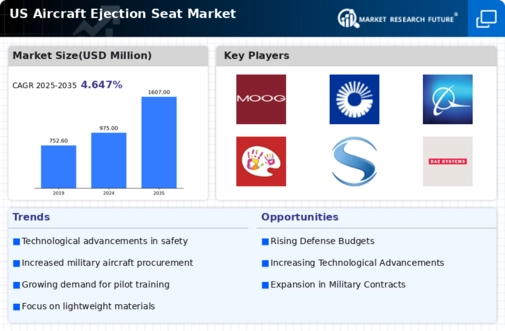Rising Military Expenditure
The aircraft ejection-seat market is experiencing growth due to increasing military budgets in the US. The Department of Defense has allocated substantial funds for modernization and procurement of advanced military aircraft, which inherently includes the need for state-of-the-art ejection seats. In 2025, military spending is projected to reach approximately $877 billion, reflecting a 3% increase from the previous year. This surge in funding is likely to enhance the demand for advanced ejection-seat systems, as military aircraft require reliable safety mechanisms to protect pilots during emergencies. Furthermore, the focus on enhancing operational capabilities necessitates the integration of advanced ejection systems, thereby driving the aircraft ejection-seat market forward.
Increased Focus on Pilot Safety
The aircraft ejection-seat market is propelled by an intensified focus on pilot safety across the aviation sector. Regulatory bodies and military organizations are emphasizing the importance of safety measures, leading to the adoption of advanced ejection systems. The National Transportation Safety Board (NTSB) has highlighted the need for improved safety protocols, which includes the implementation of more reliable ejection seats. As a result, manufacturers are compelled to innovate and enhance their product offerings to comply with these safety standards. This heightened awareness of pilot safety is likely to drive the aircraft ejection-seat market, as stakeholders prioritize the protection of personnel in high-risk environments.
Expansion of Aerospace Manufacturing
The aircraft ejection-seat market is benefiting from the expansion of aerospace manufacturing in the US. With an increasing number of companies entering the aerospace sector, there is a growing need for safety equipment, including ejection seats. The aerospace manufacturing industry is projected to grow at a CAGR of 4.5% through 2030, driven by advancements in technology and rising demand for commercial and military aircraft. This expansion creates opportunities for ejection-seat manufacturers to collaborate with aerospace companies, thereby enhancing their market presence. As the aerospace sector continues to flourish, the aircraft ejection-seat market is likely to experience concurrent growth, driven by the demand for innovative safety solutions.
Growing Demand for Military Aircraft
The aircraft ejection-seat market is significantly influenced by the rising demand for military aircraft. As geopolitical tensions escalate, nations are increasingly investing in their defense capabilities, leading to a surge in military aircraft production. The US military has plans to procure advanced fighter jets and transport aircraft, which necessitate the integration of sophisticated ejection-seat systems. In 2025, the military aircraft market is expected to reach $200 billion, with a substantial portion allocated for safety equipment, including ejection seats. This growing demand for military aircraft directly correlates with the expansion of the aircraft ejection-seat market, as manufacturers strive to meet the safety requirements of modern military aviation.
Technological Innovations in Ejection Systems
Technological advancements play a pivotal role in shaping the aircraft ejection-seat market. Innovations such as zero-zero ejection seats, which allow pilots to safely eject at zero altitude and zero speed, are becoming increasingly prevalent. These advancements not only improve pilot safety but also enhance the overall performance of military and civilian aircraft. The market for ejection seats is projected to grow at a CAGR of 5.2% from 2025 to 2030, driven by these technological innovations. As manufacturers invest in research and development to create more efficient and reliable ejection systems, the aircraft ejection-seat market is likely to witness a significant transformation, catering to the evolving needs of the aviation industry.

















Leave a Comment